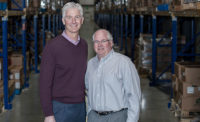
Two-and-a-half years out from the start of what some are calling “The Great Recession,” it appears that economic growth is inching its way into the lexicon once again. That bodes well for the protein industry in 2011, although most economists and market analysts do not believe it will be a rocket shot recovery.
While the plunge in the stock market in late 2008 and the subsequent “bottom” in March 2009 were hard-hitting, fast-paced wake-up calls for the economy, the rapid downward spiral made many businesses and the government more prone to rebuilding the economy slowly and piece-by-piece.
The protein industry stands among the tallest of industries in terms of resuming growth in a more deliberate, measured way. William P. Roenigk, senior vice president of the National Chicken Council, says broiler companies are counting on a drop in combined meat (beef, pork, lamb and veal) consumption to the lowest levels since 1935, during the Great Depression. They’re also banking on a more robust “away-from-home market” for chicken and a modest rebound in chicken exports in 2011.
“All three [of these] will need to occur in a measurable way for the broiler industry to sustain a profitable year,” Roenigk adds.
Three variables loom large for the broiler industry in 2011. First, he says, is whether the market can handle a broiler production increase of 3 percent or more.
Second, broiler companies will need to manage higher grain prices and the un-dampened price volatility of corn and soybeans. Robert Moskow, William Sawyer and Marcela Giraldo, research analysts covering Tyson Foods for Credit Suisse, confirm the industry concern over higher grain costs in their Nov. 22, 2010, report on the stock, stating that earnings could decline in the back half of the 2012 fiscal year, “when hedges on grain costs roll over.”
Finally, Roenigk says consumer demand needs to strengthen enough at both foodservice and retail to help offset the price/cost squeeze. Scott Brown, University of Missouri livestock economist, expects demand to play a big role in beef prices as well (See “Consumer demand to drive beef prices higher,” on page 28 for more information). Brown believes processors should be “OK” in 2011.
“Although we still have a lot of folks out of work, income growth appears likely for 2011, [which] should allow for higher prices at the retail level as well,” he says. Brown thinks the key to a recovery in consumer meat demand rests in lower unemployment rates, which need to get below 9.5 percent to spur demand recovery.
“Much of the price increase we are experiencing today is lead from shorter supplies,” he explains. “A scenario where strong demand growth coupled with what looks to be a weak supply growth in the meat markets in 2011 would push prices higher, and do it quickly.”
Donnie Smith, CEO of Tyson Foods, expects protein to be flat at retail in 2011, with chicken being a modest winner, as sourced in the Moskow, Sawyer and Giraldo report. The analysts expect a 2 percent contraction in beef supplies to be a mild positive for the chicken retail market, but that “chicken substitution on restaurant menus has not progressed as expected.”
Nonetheless, Roenigk says, broiler companies remember that history, more often than not, repeats itself. And given the movements of some beef and pork producers, it appears many across the industry agree.
“The past three years have made the surviving broiler companies stronger, more resilient, and more aware that tougher times are never far off,” he explains. “Market conditions, cost pressures and government regulatory burdens will continue to test broiler companies in 2011.”
Brown believes energy costs could play a large factor in making margins tighter throughout the supply chain in 2011, as processors continue to wind their way through the sustainability movement.
Also, though not strictly classified as economic challenges specifically, the economic impact that regulatory measures — such as the USDA’s Grain Inspection, Packers and Stockyards Administration (GIPSA) proposed livestock marketing rule and the EPA’s mandate that 13.95 billion gallons of ethanol be produced essentially from corn in 2011 — could have the industry turning on a dime in 2011.
The American Meat Institute commissioned a study by economist John Dunham of John Dunham & Associates to determine the economic impact of the GIPSA rule. On Nov. 10, 2010, Dunham authored an op-ed piece to The Oklahoman stating that if the rule moved forward, the nation would lose 104,000 jobs, along with approximately $14 billion in total revenue.
Consumer demand to drive beef prices higher
By Duane Dailey, senior writer, Univ. of Missouri Cooperative Media Group
Scott Brown, University of Missouri livestock economist, certainly doesn’t deny that, had he mentioned $1.25 fed cattle prices a year ago, he’d have been “laughed out of the room.”
“Considering the supply, you have to think stronger prices are ahead,” said Brown, with the MU Food and Agricultural Policy Research Institute. He’d been looking at feedlot prices already above a dollar, April futures prices above $1.05 and fewer calves on feed.
“We’re not seeing any slowing in that shrinking of the cow herd,” Brown added. “There are going to be fewer calves.”
But in economics, demand plays a role as well in making prices.
“The great driving force will be demand,” Brown said. “The economy has shown life and demand will return. But when? Prices are moving higher and could move up sharply if large demand recovery occurs.”
At a meeting with cattle producers at Bolivar, Mo., earlier this fall, Brown told the hazards of making price projections, explaining that, in the past, if supply was known, predicting a price was an easier task.
“Nothing is that simple anymore with a hard-hit consumer economy that slows demand,” he said. “Add great volatility in all markets, and a price outlook becomes more uncertain.”
Brown added, cow-calf producers are slow to respond to new market signals. There is a biological lag in raising calves. It takes years between the decision to produce a calf and having one ready for market.
“It’s like turning around a large towboat, instead of a speedboat,” he said. So far, cow herd numbers continue to drop, in spite of higher short-term prices. Just when feeder-calf prices were starting to rise, they were hit by higher feed costs and uncertainty in the feed supply.
“A lot depends on what happens in the corn market,” Brown told the producers, and reminded them, “In spite of a drop in projected corn harvest, we will still have the third-largest corn crop on record. Both market fundamentals and speculative activity have moved corn prices higher quickly.”
The corn supply will impact the beef price outlook, and Brown said crop allocation will be a necessary decision
“Without policy change, we will continue to have volatility,” he said, adding that there is a big supply of corn this year. But think what could happen next year. There is competition for corn ground from other sources.
“If we plant fewer acres and then have a shortage of rainfall, it could become a pretty scary scenario,” he explained. Brown urges cow-calf producers to look beyond the short-term feed outlook.
“The market still comes down to supply and demand,” Brown said. “Cow numbers are shrinking, there will be fewer calves and domestic demand will recover. Current macroeconomic outlooks do not point to a double-dip recession.”
For more optimism, Brown said, add growing international demand. Both Korea and Japan reopened their trade for more high-quality beef.
“International consumers will battle domestic consumers for our restricted supply of meat,” Brown said. “That’s very positive for prices.”
This story was supplied by the University of Missouri Cooperative Media Group. For more information, contact Duane Dailey at (573) 882-9181 or Scott Brown at (573) 882-3861.





Report Abusive Comment